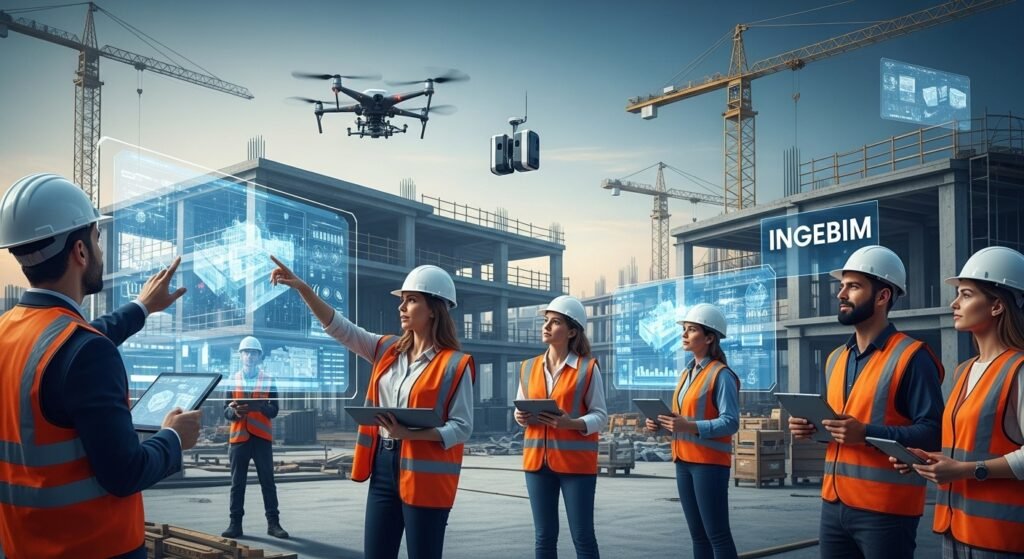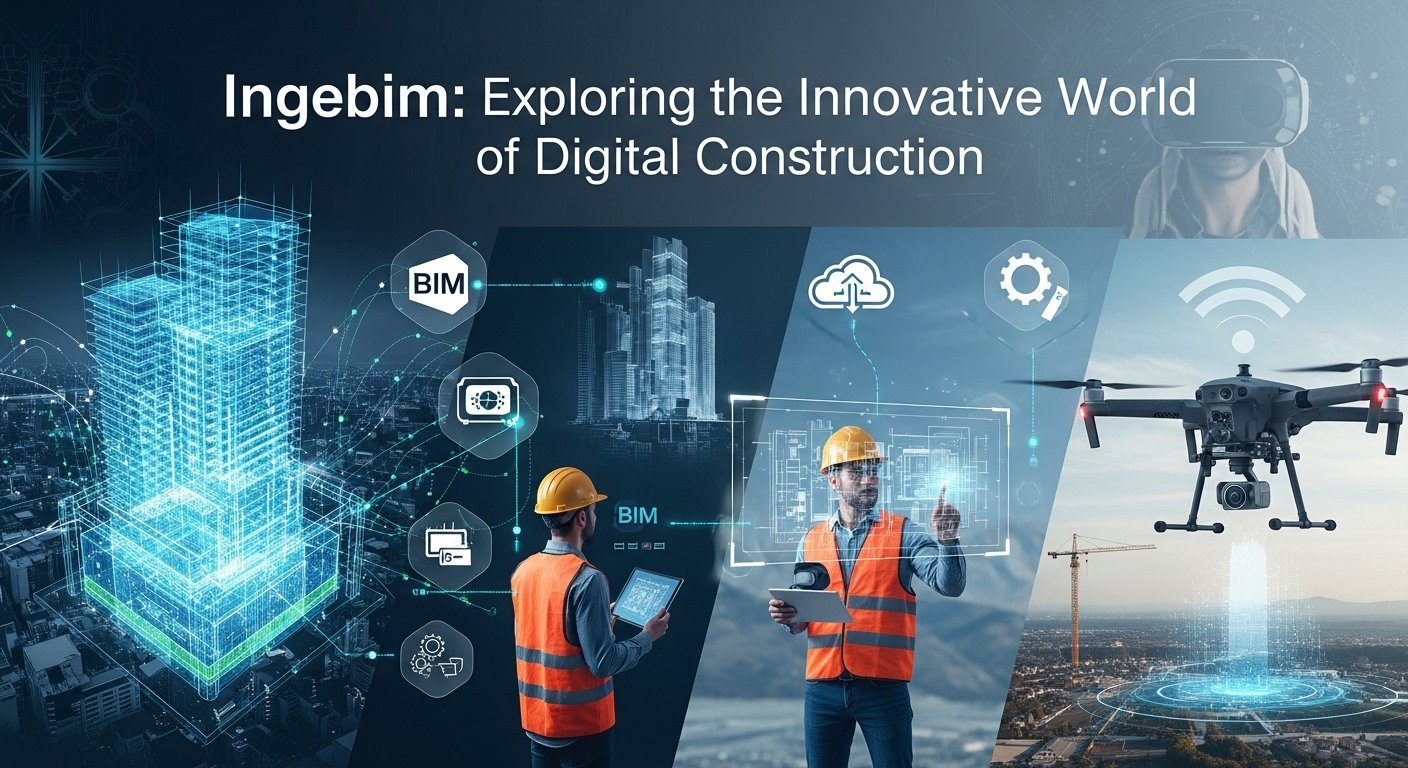Ingebim: Exploring the Innovative World of Digital Construction
Table of Contents
Construction today is moving fast. Buildings are getting taller, smarter, and more complex. But with all that growth, companies need tools to build better, work faster, and stay on budget. That’s where Ingebim comes into play. This powerful digital tool is changing the way leaders in construction think and work. From design to development and even maintenance, Ingebim helps teams see the whole picture—before anything is built. Imagine a virtual version of a building, complete with data, timelines, and tools that let you plan every detail. It sounds futuristic, but it’s happening right now. In this guide, we’ll take a closer look at how Ingebim works, why it matters, and how it’s helping the construction industry stay competitive in a digital world. If you’re a builder, architect, engineer, or just someone curious about how technology is upgrading construction, you’re in for a treat. Let’s learn how Ingebim is helping to shape the future—one smart structure at a time.
What Is Ingebim?
Ingebim is a platform that combines engineering, construction, and digital modeling into one smart system. The name is a blend of “engineering” and “BIM”—which stands for Building Information Modeling. BIM is a method used to create and manage digital versions of buildings. Ingebim takes this idea and makes it even easier to use. It lets architects, engineers, builders, and project managers work together on one version of a structure before it’s built. Everyone can see the same plans, check for errors, and stay on the same page. This helps reduce mistakes and saves time and money. Ingebim is not just one software tool—it’s a full solution that connects people, data, and technology. With it, teams can create smart building models that include not just walls and floors, but also information like cost, timeline, materials, and energy use. It’s like having a 3D map that talks back and keeps track of everything.
Why Ingebim Matters in Construction
Construction projects are big. They involve lots of people, parts, and steps. Small mistakes can turn into big problems fast. That’s why using something like Ingebim is a smart idea. It makes sure everyone sees the same plans and uses up-to-date data. That means fewer mix-ups, better teamwork, and smoother jobs. Ingebim also helps spot clashes before people start building. For example, if a pipe goes through a wall by mistake, the software shows it so it can be fixed early. This avoids costly delays and construction errors on-site. Ingebim also tracks material usage, budget changes, and even energy performance. This way, companies stay organized from the start to the end of a project. Whether you’re working on a tall office building or a small house, Ingebim helps make sure the final product is safer, stronger, and better.
How Ingebim Works
Using Ingebim starts with creating a digital building model. This model includes walls, floors, lights, pipes, and many other parts of the real structure. You’re not just drawing it—you’re building it in a digital space with all the important details. Engineers use software tools like Revit or ArchiCAD, which can be linked to Ingebim for seamless management. Once the model is ready, different specialists jump in. Electricians, plumbers, and structural engineers all look at the design to check for issues. Ingebim lets them update the plan and leave notes. Everything is saved, so anyone on the team can see updates right away. The tool also tracks changes over time. This helps project leaders stay on top of progress and solve problems quickly. It also creates useful reports for clients, showing what’s done and what’s next. Ingebim helps everyone stay on schedule and in sync.
Benefits of Using Ingebim in Building Projects
There are many benefits to using Ingebim in construction. First, it makes planning better. Teams can work together in real-time, even if they are far apart. This helps avoid delays caused by confusion or bad communication. Second, it saves money. When problems are caught early, fixing them is cheaper than after you pour concrete or install pipes. Third, Ingebim helps make buildings stronger and safer by ensuring every system fits and works together. The tool also supports eco-friendly building by tracking energy use, materials, and carbon output. It’s helpful for both short and long projects. Whether you’re working on a month-long build or a two-year tower, Ingebim helps with timelines, deadlines, and budgets. It also holds everyone responsible since each change is recorded and tracked. In short, it leads to better builds, smarter teams, and happier clients.
How Ingebim Supports Collaboration

Teamwork is key in construction. Many people work on a single building—designers, builders, suppliers, and clients. Without good tools, they may not always agree or understand each other. That’s where Ingebim shines. It brings everyone together in one shared digital space. Each team sees the same model with the same updates, no matter when they log in. This makes it easier to work together and avoid mistakes. Need to ask a question or share a fix? Leave a comment directly on the model. Want to show a change made yesterday? It’s already saved in the timeline. Ingebim makes it simple to track who did what and when. This keeps the project moving and avoids repeating work. When every person is on the same page, buildings are better, and deadlines are easier to meet.
Ingebim and Sustainable Construction
Sustainability is a big focus in today’s construction projects. People want buildings that are comfortable, efficient, and kind to the earth. Ingebim supports this goal in many ways. First, the platform helps track what materials are being used and how much energy the building will use once it’s built. This helps planners choose better options, such as eco-friendly insulation, glass, or lights. Next, the model can study things like air flow, sunlight, and water usage. With that, the team can make smart choices, like placing windows in the right places or using technology to reduce waste. Ingebim also helps guide the project from design through long-term use. Facility managers can use the data years later to upgrade systems or improve performance. That means using Ingebim makes a building green—not just during construction, but for its whole life.
Ingebim for Small Projects and Big Builds
One great thing about Ingebim is that it works for all project sizes. You don’t have to be building a skyscraper to benefit. Even small houses or renovations can use the tool to plan, track, and save time. For small teams, Ingebim is like having a smart assistant that keeps everything in one place. It helps avoid mistakes like ordering the wrong part or missing a building code. For large-scale projects like schools, malls, or hospitals, Ingebim handles multiple teams and offers real-time updates. It can show how one change affects the rest of the plan—before any work begins. Whether the project lasts three weeks or three years, this platform helps construction happen in a smart, organized way. It’s flexible, scalable, and always ready for the next job.
Training Your Team to Use Ingebim
Switching to a new tool can feel hard, but Ingebim makes learning easy. Most teams pick it up quickly with guided lessons, webinars, or simple tutorials. Many engineering schools now include BIM tools in their training programs, so younger workers may already know how it works. For older professionals, short courses are available to learn it step-by-step. Leaps in teamwork and speed make the small training investment worth it. Teams can also practice with demo projects before using it on a real job. That way, they feel confident and ready. Once everyone’s trained, daily tasks go faster. Even if team members speak different languages or live in different places, the visual model and simple design of Ingebim make sharing ideas easy. With just a few hours of training, you can have your crew working smarter than ever before.
Ingebim and Project Timelines
Finishing a job on time is important. Delays lead to cost overruns and upset clients. Using Ingebim helps prevent this because the tool shows every step of the project in one place. You can schedule tasks, set deadlines, and track changes as they happen. If one task falls behind, the system alerts the team so they can fix it right away. The visual timeline lets everyone—managers, workers, and clients—see what’s next. No more waiting days for updates. If supplies are late or weather changes the plan, just adjust the schedule in the model. Everyone sees the change and stays on track. Planning becomes clearer, problems are easier to solve, and surprises are rare. That means happier clients and successful builds.
How Ingebim Helps After Construction
Many people think construction ends when the last nail is in place. But buildings need care after they’re built. That’s why Ingebim is useful even after the project is complete. Building owners can use the digital model to manage repairs, check equipment, and make upgrades. Since all the information is included in the model—like wiring, water pipes, and air systems—there’s no guesswork. If a heater breaks five years later, the facility manager can check the model and find the exact brand and placement. If they want to add something new, like solar panels, Ingebim helps plan it safely and easily. Stakeholders also use the data to save energy or improve safety over time. A living digital model proves useful from start to finish—and beyond.
The Future of Construction with Ingebim
The future of smart building is growing fast, and Ingebim is leading the way. As technology evolves, so does the way we build. Ingebim is adding new tools like AI alerts, real-time drone data, and 3D printing support. Soon, teams may be able to build entire structures with just tablet input and digital plans. Ingebim can connect future tech like smart sensors, digital twins, and energy trackers into one hub. This helps teams move faster, safer, and greener. It also builds trust with clients who want to see clear progress every step of the way. Schools, hospitals, and even cities are now planning entire projects digitally before touching the ground. With tech like Ingebim, tomorrow’s buildings will be cleaner, smarter, and more efficient from day one.
Conclusion
In today’s changing world, the way we build needs to be smarter, faster, and safer. That’s why tools like Ingebim are so important. They don’t just help builders plan projects—they help entire industries grow. Whether you’re building a small home or leading a major city project, using Ingebim makes life easier. It improves communication, avoids mistakes, saves money, and builds better teamwork. It even helps make the world more sustainable. From planning and design to long-term use, Ingebim keeps things running smoothly. If you’re new to the tool, now’s the time to learn. If you’re already using it, keep exploring what’s possible. Either way, the future of construction is here—and with Ingebim, it looks bright.
FAQs
1. What is Ingebim used for?
Ingebim is used to plan, manage, and track construction projects using smart digital building models.
2. Is Ingebim only for big companies?
No. Both small firms and large companies can use Ingebim to manage jobs of all sizes easily.
3. How does Ingebim save money?
It lowers costs by catching errors early, improving teamwork, and helping teams avoid delays or waste.
4. Can I learn to use Ingebim if I’m new to tech?
Yes! It’s made to be user-friendly, with easy guides and helpful training to get you started.
5. Does Ingebim help with green building?
Absolutely. Ingebim tracks energy use, materials, and eco-friendly design so buildings can be more sustainable.
6. What makes Ingebim better than regular blueprints?
Unlike paper plans, Ingebim’s models are 3D and interactive. They update in real-time and include detailed project info.








Post Comment